Wings of Angels Family Tree
Sarah Emeline (Hunt) Bosworth 1832-1908

Sarah Emeline (Hunt) Bosworth
On October 17th, 1832 Sarah Emeline Hunt was born to Ward Ensign and Mary (Bascom) Hunt in Perrysburg, Cattaraugus, New York, USA. Ward Ensign Hunt was from Vermont and Mary Bascom from Massachusetts. Ward and Mary (Bascom) Hunt were very early pioneers of western New York.
Sarah’s parents had 12 children: Hiram Bascom Hunt (1818-1852), Henry Ensign Hunt (1819-1893), Rev. Ward Isaac Hunt(1820-1904), William Edwin Hunt (1822-1889), an infant-unknown name (1824-1824), Reuben Gay Hunt (1826-1861), Mary Elizabeth Hunt (1827-____), Joshua Bascom Hunt (1830-1835), George Hunt (1832-____), Sarah Emeline Hunt (1832-1908), Ellen Hunt (1834-1854) and Aaron Bascom Hunt (1837-1900).
Sarah Emeline Hunt was a teacher by training and experience. In the book “Biography of a Mind: Bosworth of Oberlin,” Sarah wrote an account of her life and in it she spoke of her mother “keeping abreast of current events. I remember her telling us that the Civil War was inevitable.” Widowed early in life, the mother was deeply religious and practically poised. “She would take me on horseback, in front or behind her,” to attend the Presbyterian church some four miles from the family farm in northwestern New York state. Sarah writes of her mother, Mary Bascom’s, influence upon her own life: “Parents should remember that in training children they are also training grandchildren indirectly.”
In Cleveland, Cuyahoga, Ohio, Miss Hunt was a public school teacher and teacher at Collamer Academy. Later, Sarah Emeline Hunt taught at Notre Dame located in St. Joseph County, Indiana. It was there Sarah met her future husband, Franklin Smith Bosworth who was actually a student of hers. Both were of the same age at the time.
Sarah Emeline Hunt and Franklin Smith Bosworth (1832-1919) were joined in marriage Jan. 4, 1859 in Dundee, Kane County, Illinois. At that point it appears Sarah’s career in teaching ended.
In 1852, Franklin S. Bosworth was engaged in business with his uncle, Increase C. Bosworth, in Dundee. A home tour in 1975 featured the Franklin Bosworth home at West Main and Fourth Streets in Dundee, Illinois as one of their homes of interest.
After about 20 years, Franklin and Sarah established their home in Elgin. An 1880 U. S. Census shows the couple and their daughter, Mary Abbie, along with a servant, Mary Moran, living at 37 Fulton Street. Franklin is listed on that census as a hardware merchant. Another census shows them at that home with their son, Frank Hunt Bosworth.
The Bosworths had four children: Reuben Hunt Bosworth (1859-1860), Dr. Edward Increase Bosworth (1861-1927) of Oberlin College, Mary Abbie Bosworth (1867-1942) and Frank Hunt Bosworth (1870-1919) a mayor of Elgin, Kane County, Illinois.
Sarah’s husband, Franklin S. Bosworth, held several terms as mayor of Elgin, Kane County, Illinois and her son Frank Hunt Bosworth was mayor of Elgin for one term.
In an 1877 newspaper article in the “Inter Ocean” mentioned Sarah’s membership in the Women’s Temperance Union in Kane County, Illinois.
The family attended the Congregational Church in Elgin, in which Franklin S. Bosworth held several official positions. We learn from another newspaper clipping that Sarah E. (Hunt) Bosworth, at the age of 57 years old, gave the welcoming speech at the local Baptist Church for the fifth annual meeting of The Ladies Home Missionary of the Congregational Church on May 21, 1890.
Sarah Emeline (Hunt) Bosworth passed away June 25, 1908 in Elgin, Kane County, Illinois. She is buried with her husband in Dundee Township Cemetery West in Kane County, the place they began their life together and raised their family.
——–
Respectfully submitted by Tenderly Rose Robin Melissa Bosworth, great great granddaughter of Franklin Smith and Sarah Emeline (Hunt) Bosworth – September 26, 2018
Sarah Emeline HUNT (1832 – 1908)
2nd great-grandmother
—–
Frank Hunt BOSWORTH I (1870 – 1919)
Son of Sarah Emeline HUNT
Wilder Morris BOSWORTH Sr. (1905 – 1990)
Son of Frank Hunt BOSWORTH
Frank Hunt BOSWORTH (1933 – )
Son of Wilder Morris BOSWORTH Sr.
Tenderly Rose Robin Melissa BOSWORTH
Tthe daughter of Frank Hunt BOSWORTH II
Dundee Pioneer Charles Blow A Hero at 94 Years Old
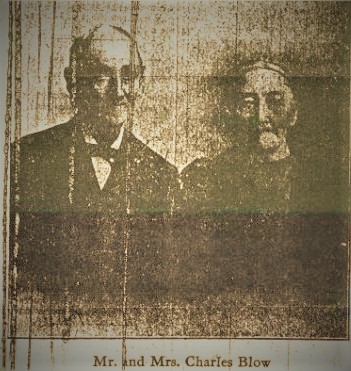
The Rock Island Argus
July 18, 1913
Page 9
***
HUSBAND, 94, SAVES WIFE FROM FLAMES
Stairway Crashes as Aged Man Bears Helpmate Away from Burning House.
***
Muscatine, Iowa, July 18
Heroism which parallels that of genuine fiction was exhibited by Charles Blow, 94 years old, from possible death in a fire which totally destroyed the residence of Mr. and Mrs. J. A. Contriman at Fruitland yesterday.
The aged people were in the home alone at the time of the fire. They have been guests at the Contriman home for the past several weeks, coming here from their home at Elgin, Ill. Their daughter, Mrs. Contriman was out in the pasture while Mr. Contriman was in the field.
The fire was discovered by Mr. Blow just as he had descended to the kitchen preparatory toward securing his breakfast. Considerable headway has already been made by the fire, a gust of flame enveloping him as he opened the kitchen door. Staggering from the noxious fumes he pluckily made his way upstairs where his wife was dressing. The aged woman was almost prostrated by the smoke which filled the upstairs portion of the dwelling and her husband practically carried her down the flight of the stairs. The passageway was dense with smoke and the two old people were compelled to fight their way to safety blindly. Flames singed the hair of both although neither was otherwise injured.
Barely a minute after they reached fresh air, the stairway crashed in.
The home was burned to the ground in its entirety. Nothing was saved. The loss to the furniture is estimated at about $1,500, while to the dwelling about $1,2000. The house was owned by Theodore Drake, a well known Muscatine Island resident. But a small amount of insurance was carried. The dwelling had recently been remodeled but since the improvements the insurance had not been increased.
Mr. and Mrs. Contriman had made their home in Fruitland since last February coming here from Chicago.
daughter of Charles BLOW
son of Maria Elizabeth BLOW
daughter of Frederick Judson “Fred” HOAGLAND
son of Helen Marie HOAGLAND
Me, the daughter of Frank Hunt BOSWORTH
Mr. Charles Blow and his wife, Lucy Flude Knott, are my 3x great grandparents.
Submitted by Tenderly Rose-Robin Melissa Bosworth Reininger
Dundee Pioneer Charles Blow Member of the Old-Time Jimmy-Pipers Club at age of 94

4 May 1915, Decatur, Illinois
The text insert located on the lower left-hand corner of this advertisement, just under the drawing illustrating Charles Blow, states:
“This is Charles Blow of Dundee, Ill., who tips the scales at 94 years. Mr. Blow is today, and always has been, a man who smoked his pipe liberally–and enjoyed it mightily. Mr. Blow qualifies for the Prince Albert “old-time jimmy-pipers club” and has been elected to full-fledged membership. We would like to hear from other old-time smokers.”
Charles Blow was married to Lucy Flude Knott
“Wings of Angels”
https://www.ancestry.com/family-tree/person/tree/5680810/person/-1416081224/facts
Charles BLOW (1820 – 1919)
My 3rd great-grandfather
Maria Elizabeth BLOW (1854 – 1953)
daughter of Charles BLOW
Frederick Judson “Fred” HOAGLAND (1880 – 1961)
son of Maria Elizabeth BLOW
Helen Marie HOAGLAND (1907 – 1965)
daughter of Frederick Judson “Fred” HOAGLAND
Frank Hunt BOSWORTH (1933 – )
son of Helen Marie HOAGLAND
Tenderly Rose-Robin Melissa Bosworth
the daughter of Frank Hunt BOSWORTH
“The Flames” – Biloxi Business District in Ashes – October 13, 1894
Biloxi Daily Herald
…
October 13, 1894
…
THE FLAMES
…
A PORTION OF THE PRINCIPAL STREET OF BILOXI IN ASHES.
…
Business Houses and Residences Were Burned Like so Much Chaff
…
LOSS ABOUT $75,000—INSURANCE $28,000.
…
Heroic Action of Firemen and Citizens
…
Biloxi has again been visited by a conflagration more sweeping in extent and entailing a financial loss greater than that of the fire of June, 1889. Friday morning about 2 o’clock a private watchman discovered flames issuing from the two-story building of Jos. W. Swetman, located on Pass Christian st., main thoroughfare, and in the most densely populated portion of the city. The alarm was sounded and the fire department turned out in quick order, but the flames had gained such headway that it was impossible to save the building and efforts of the firemen were directed to those adjoining. The Swetman building was occupied by J. W. Swetman a drug-store with sleeping apartments on the second floor occupied by his family, and so rapidly did the fire eat its way that the family were only able to hastily gather a few articles of clothing and make their escape. Another portion of this building on the first floor was occupied John W. Henley, as a oyster saloon. Adjoining the Swetman building, and on the west the fire quickly communicated to the engine room of Mechanics Fire Co., and from that to the Masonic Opera House, a large frame structure. Continuing its course west, on Pass Christian street, the two buildings owned by John Eistetter, one occupied by J. H. Murphy as a blacksmith shop, and the other by P. Ferzar, as a lunch house, were consumed as was also the tin shop belonging to Dan Markey, and a small residence, both in the rear and owned by Jno. Eistetter. Crossing Magnolia street the storehouse and dwelling of Miss St. Tual was soon in ashes. The fire in its eastern course was checked with the burning of the market-house of Felix Borries, by the most desperate and heroic work on the part of both firemen and citizens.
…
Before this time, however, buildings were burning in all directions, and it looked as if the larger portion of the city would be consumed before the wrath of the fiery monster was appeased. Opposite the Opera House the large two-story business house and dwelling of S. Picard was in flames, and in the flying cinders the intense heat almost immediately ignited the residence of W. K. M. Dukate, on the east and a cottage on Magnolia street, owned by N. Voivedich and occupied by F. W. Eaton. With the destruction of the last named building the flames were, checked on Magnolia street, although the house south of it and occupied by T. E. Colline, was badly scorched.
…
On the south side of Pass Christian street the residence of Mrs. Rich and a small building adjoining, occupied as a candy store were being rapidly reduced to ashes only to be followed in quick succession by the building occupied by Joseph Lawrence as a shoe shop, and the barber shop J. Kilk both owned by George Ohr, Sr. From the barber shop the next to fall a prey to the fiery demon was the large two-story building owned by Chas. Redding and occupied by him as a residence and grocery store. South of Redding’s a cottage belonging to Dr. J. J. Lemon and occupied by Mrs. Kelty, was burned as was also a two-story cottage adjoining, belonging to Geo. Ohr, Sr. On the north side of Pass Christian st., and east of the Swetman building, four small buildings owned by the same gentlemen, were destroyed—one of these was without a tenant and the other occupied by Sing Lee as a laundry; H. Eikel, merchant tailor; and Mrs. Ohr, grocer.
…
The fire in this direction was checked at the building owned by Mrs. Amare and occupied by Keel & Jennett, grocers. This building was damaged to the extent of about $100, and it seemed at times beyond the power of human beings to save the structure and it was only by almost superhuman efforts that the flames were checked at this point. The destruction of this building would have followed by the loss of many more, and with this appalling fact staring them in the face the firemen worked with redoubled vigor and until their hands and faces were scorched and blistered by the devouring element.
…
In the rear of the property last destroyed stood the famous pottery of Geo. E. Ohr, whose shop during the past severel [sic] years has been visited by hundreds of visitors from other sections and from almost every State in the Union, seeking relics in artistic pottery. In a few moments the toil and work of Ohr, the artistic potter, was reduced to ashes.
…
In the rear of the opera-house the planning mills of John R. Harkness & Sons, together with a large amount of finished work and lumber, was destroyed.
…
In the upper story of the opera-house were the lodge rooms of the Masons and Knights of Pythias. The regalia and all paraphernalia of both orders were completely destroyed, only the secretary’s and treasurer’s books of the Masonic order being saved.
…
On the ground floor of the opera-house was the office of the Postal Telegraph Co., and the watch-maker shop of B. M. Root, both suffering a total loss.
…
Fortunately there was but little wind during the conflagration, else the damage would have been more than doubled. As it was, houses several blocks away from the seat of the fire were ignited by flying cinders, and it was only by the closest surveillance that many other buildings were not added to the conflagration.
…
The Convent of Mercy, situated some distance from the scene, was on fire twice, but before gaining any headway, the flames were extinguished.
…
During the height of the fire, and until it was well under control, much excitement prevailed among residents in the neighborhood. Houses were emptied of their contents, and vehicles of all sorts were pressed in service to aid in conveying the goods to a place of safety. In many instances this was found to be unnecessary. Household goods were piled helter-skelter in every direction, and when daylight came, the scene presented cannot be described. The area of the fire covers the larger portion of four squares in the heart of the city and as the buildings destroyed were all of wood, there was little resistance to the flames.
…
[Partially illegible paragraph] paraphernalia, $500; insurance on opera-house, $1500.
Knights of Pythias, $1000; insurance, $600.
Geo. Ohr, Sr., $5000; no insurance.
John R. Harkness & Sons, $3000; no insurance.
Miss St. Tual, $700; insurance, $2000.
Geor E. Ohr, $3000; no insurance.
H. Eikel, $2800; insurance $1000.
J. Kilk, $400; no insurance.
Jos. Lawrence, $100; no insurance.
Mrs. Rich (2 houses), loss unknown.
Dan Markey, $250; no insurance.
Mechanics’ Steam Fire Co., $400; no insurance.
J. H. Murphy, $100; no insurance.
Felix Borries, $400, no insurance.
N. Voivedich, $700; no insurance.
F. W. Eaton, $00; no insurance.
J. Eistetter, $1000; no insurance.
B. M. Root, $400; no insurance.
P. Ferrar, $800; no insurance.
…
The insurance is divided among the following companies of E. W. Morrill’s agencies:
Royal $00; Harford, $6450; American Fire, $2345; Phoenix of London, $2275; Phenix of Brooklyn, $2550; Lancashire, $2000; Queen, $1500; Liverpool, London and Globe, $3500; Mechanics and Traders, $3200.
…
In but few instances was any portion of the contents of the burned buildings saved, and then only in a damaged condition. There is also considerable loss in the way of outhouses, stables, fences, etc.
…
The Electric Light Co. lose [sic] about $6000 in the destruction of poles wires, transformers, etc.
…
Many of those burned out will commence rebuilding at once. The loss is a severe one to our people, and to many is the loss of all their possessions. The business men who own property along Pass Christian st., to whom a Herald reporter has talked to on the subject signify their willingness to widen the street ten feet on either side than its present width.
…
The Herald building was threatened by flying cinders, and had it not been covered with abestos [sic], there is but little doubt that the roof would have ignited and it would have been almost impossible to have saved the building from destruction, and that or other and valuable property. Owners having property in the west end of town can thank their lucky stars that this office was covered by asbestos [sic], for had it burned the destruction would have been three fold greater than now recorded.
My great great grandfather John Rankin Harkness’s business is mentioned as destroyed in this article. Capt. John Rankin Harkness (1830-1903) was one of the founders of the Biloxi Fire Dept. He was born in Pelham, Hampshire, Massachusetts, the son of William Harkness and Abigail Turner.
Capt. John Rankin HARKNESS (1830 – 1903) — My 2nd great-grandfather
Edna Irene HARKNESS (1880 – 1952), daughter of Capt. John Rankin HARKNESS
John Harkness MORRIS (1901 – 1965), son of Edna Irene HARKNESS
Janie Lucille MORRIS (1935 – 2013), daughter of John Harkness MORRIS
Me, the daughter of Janie Lucille MORRIS
D. E. Morris in Moss Point Odd Fellows Lodge
The Pascagoula Democrat-Star
May 04, 1894
…
Moss Point Secret Societies
…
Moss Point Lodge N. 117 I. O. F. [sic] meets every Monday night at K. of H. hall. D. E. Morris, N. G.; A. F. Dantzler, Secretary.
“I. O. O. F.” is an abbreviation of the Independent Order of Odd Fellows. David Edmund “D. E.” Morris was my great grandfather and was best friends with the Dantzler family. – Note from TRose
Me and My Daddy Jim
“Old as she was, she still missed her daddy sometimes.”
—Gloria Naylor
I was born a Bosworth, but, my parents divorced before my first birthday and I never knew my biological father until I graduated from high school. So, my “Daddy Jim Estrada” is the father I knew as my special angel when I was growing up on the Mississippi Gulf Coast as an Air Force brat. My Daddy Jim adopted me when he married my mother – I was just a little tiny girl about 2 1/2 years old. I remember so much about him. He was a wonderful daddy to me. Sadly, he was killed as a pilot flying in the USAF flying Strategic Air Command program when we were stationed at Bunker Hill Air Force Base in Indiana. I was just six when a terrible accident happened. He was flying in a B-58 (“Hustler”) bomber. One day I’ll write the story of my Daddy Jim. I am just as devastated today by his death as I was when I was told he was killed. It is a difficult thing to remember back to his death, but, it is a story worth telling as it colored my whole life and my perceptions of life in general. Little girls need their daddies.

- Jim Estrada and Tenderly Rose
-

Not a very good photo of a photo – but, it is priceless to me. This is Daddy Jim and me at the Biloxi Amusement Park. 
When we were stationed at the Air Force Base in Altus, Oklahoma we went on a picnic after my baby “tister” was born. This is me and Daddy Jim and my “Lambie”. 
Daddy Jim Estrada and Tenderly 1959 when we were stationed at the Air Force base in Altus, Oklahoma.

- Visiting Mamaw (Rosie S. Morris) at Easter Time. At this time we were living in Oklahoma, but, always visited Mamaw whenever we could. – In this photo: Me, Daddy Jim and my sister at Hungry Hill on Wisteria Street in Gulfport, Mississippi.
Thinking of Mamaw – today is her birthday…

Photo of my grandmother as a young woman fresh out of nursing school at Rockefeller Hospital. Cir. 1915. She was born and raised in the Mississippi woods. She was the daughter of John George Smith and Mary Jane Rice of Seminary, Mississippi. Rosie was a private duty nurse and registered nurse at Kings Daughters Hospital and Gulfport Memorial Hospital. Her daughter, Jane Morris Estrada, was my mother.
BIRTH: 8 DEC 1895 • Seminary, Covington, Mississippi, USA
DEATH: 31 MAR 1984 • Gulfport, Harrison, Mississippi, USA
James Knott 1804–1874, Elgin’s Grocer
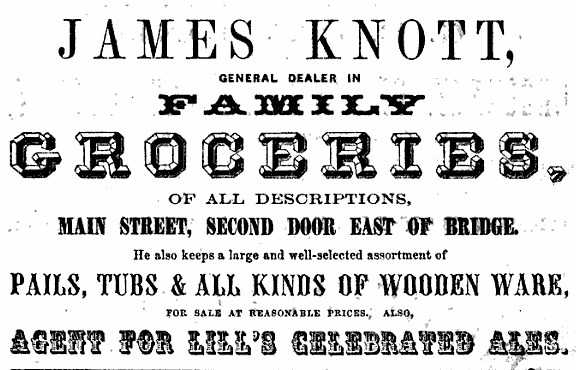
When James Knott was born about 1804, in Leicester, Leicestershire, England, his father, Thomas, was 13 and his mother, Anna, was 17. He was married three times and had three sons and two daughters. He died on March 5, 1874, in Elgin, Illinois, at the age of 70, and was buried there.
James KNOTT (1804 – 1874)
My 4th great-grandfather
daughter of James KNOTT & Deborah FLUDE
daughter of Lucy Flude KNOTT
son of Maria Elizabeth BLOW
daughter of Frederick Judson “Fred” HOAGLAND
son of Helen Marie HOAGLAND
The daughter of Capt. Frank Hunt BOSWORTH II
James Knott married Deborah Flude in 1822 in Leicester, Leicestershire, when he was 18 years old.
St. Nicholas Church – “England Marriages, 1538–1973 ,” database, FamilySearch (https://familysearch.org/ark:/61903/1:1:NJ8W-TQK : accessed 24 February 2016), James Knott and Debora Flude, 25 Aug 1822; citing St. Nicholas, Leicester, Leicester, England, ref
Read about Deborah Flude by clicking on this link:
https://thetenderlyrosecollection.wordpress.com/2016/08/30/deborah-flude-1800-1847/
Excerpt from British History Online:
“Of the other early shoemakers, James Knott advertised himself in 1842 as a ‘Fashionable Boot and Shoe Manufacturer’, who supplied the trade as well as private customers and executed shipping orders. He continued to appear with his son, Thomas, in the lists of boot and shoe manufacturers until 1850.”
‘The City of Leicester: Footwear manufacture’, A History of the County of Leicester: volume 4: The City of Leicester (1958), pp. 314-326. URL: http://www.british-history.ac.uk/report.
My note: Is it possible that the author of this history may have listed James as the father of Thomas in error. In my research, Thomas Knott was the father of James Knott. But, I am just beginning to gather information on this family, so I may be incorrect in my information. Would love to hear from anyone familiar with this family.
After Deborah’s death in 1847, James Knott arrived in America on June 28, 1849 in New York, New York after a 38 day voyage on the ship named Guy Mannering. The ship’s manifest lists James Knott 45, William Knott 18, Anne Knott 20, Eliz. Knott 16 and Fred Knott 12. His oldest child, Lucy, my GGG Grandmother, was not listed on the manifest with her family. I found she had traveled ahead of the family to America and was living with her Uncle John Knott in Chicago at the time of her family’s arrival.
Around 1849-1851, James Knott married Elizabeth Anne Hawly (1800-1852) in Illinois.
On the 1850 U.S. Federal Census the family is living in the Town of Elgin, Kane County, Illinois. The census lists James Knott 46, Elisabeth Knott 26, Elisabeth Knott 18, Frederick J. Knott 13. Only James is listed as having been born in Illinois. On the ship’s manifest for James Knott upon arrival to the U.S., an Elizabeth is listed, so at least that would indicated she was born in England, not Illinois. The same page of the census also shows his father, Thomas Knott 61 with Ann Knott 63-both born in England-his occupation is “Tanner or Tuner”.

After the death of James’ second wife, Elizabeth Hawly, he then married Charlotte Bunce on November 18, 1852.

James Knott is listed on the Illinois State Census for 1855 as residing in Elgin, Kane, Illinois.
A U.S. IRS Tax Assessment List for Illinois, District 2, for 1862-1864 lists James Knott as “Retail Dealer”, but then that was crossed out and it looks like “Butcher” was written beside it. Another U.S. IRS Tax Assessment List for the same district lists James Knott as “Retail Dealer”.
On the 1870 U.S. Census for Elgin, Kane, Illinois, James Knott is listed as “Retired Merchant” with possible wife (3 years younger), Charlotte Knott & Margaret Bunce (whom I found on a census in PA with George F. Knott on same page – Marg. was listed as domestic) at same address.
James Knott is listed as buried in the Channing Street Cemetery (Channing Street Cemetary Sexton’s Certificates) on March 5, 1874, however, the Channing Street Cemetery was “repurposed” for the building of a school. The story is here:
http://www.elginroots.com/index.php?option=com_content&view=article&id=18&Itemid=146
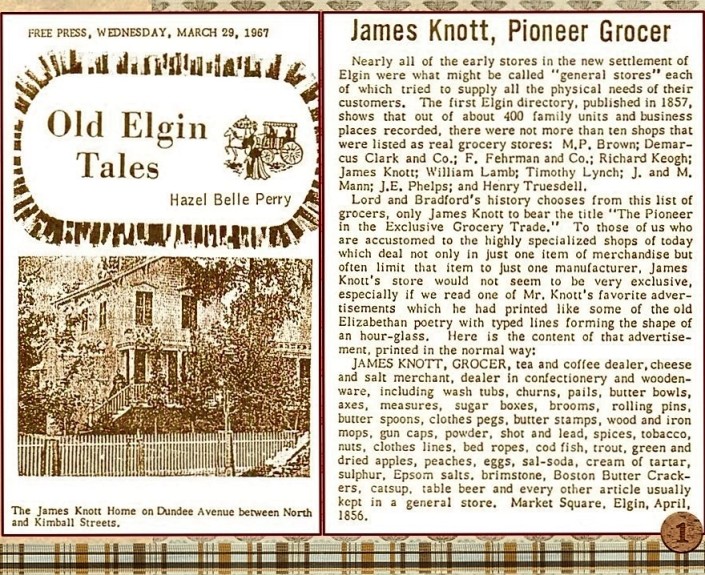
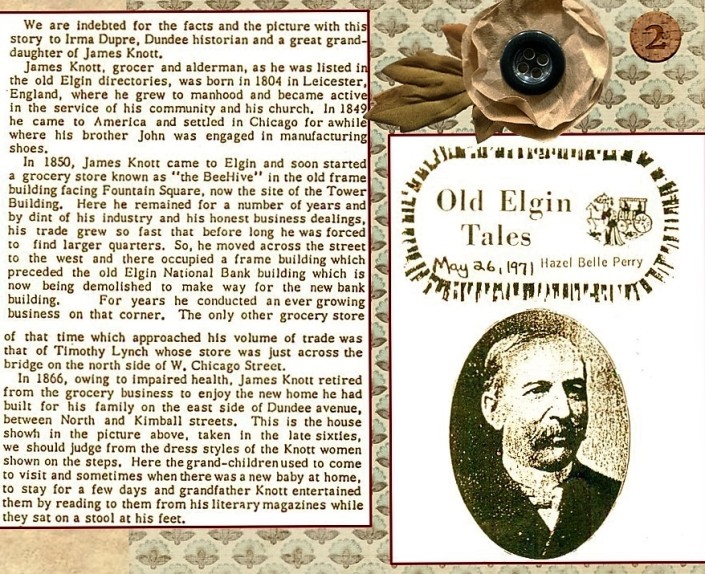
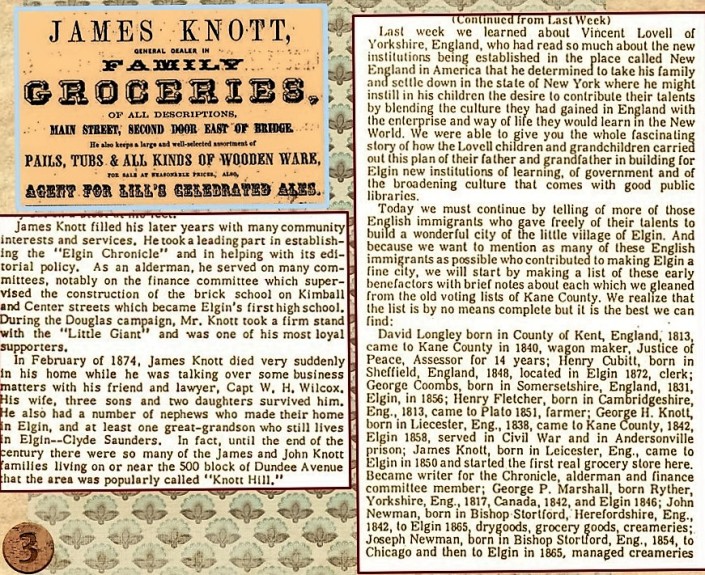
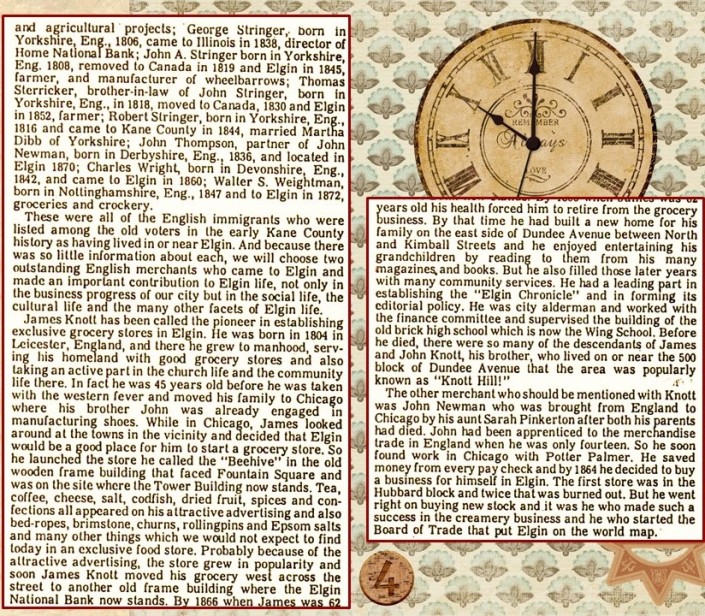
Deborah FLUDE (1800 – 1847)
Deborah FLUDE Knott (1800 – 1847)
My 4th great-grandmother
daughter of Deborah FLUDE
daughter of Lucy Flude KNOTT
son of Maria Elizabeth BLOW
daughter of Frederick Judson “Fred” HOAGLAND
son of Helen Marie HOAGLAND
The daughter of Capt. Frank Hunt BOSWORTH II
Forget Me Knott
BBC Leicester’s Tony Wadsworth goes in search of a Leicester woman who was born, married and buried in the same street.
How often do you pass familiar buildings, statues and objects in the street without giving them a second thought?
One sunny day BBC Leicester’s Tony Wadsworth stopped to take a look round the churchyard he walks past everyday, and found one woman’s remarkable story amongst the gravestones.
It got him thinking about the area around St. Nicholas Church and how it had changed since her days in the 1800s, and even in the last 50 years.
Deborah’s Death
Deborah’s death certificate states that she died of “enlargement of the liver” and “heart disease”.
BBC Leicester’s Julie Mayer spoke to Dr Clive Harrison to find out what could have caused Deborah’s poor health…
Leicester in the mid 1800s was a very different place from the city we know today and the environment would have affected everyone’s health.
In 1813 the Inspector of Nuisances, George Brown painted the city conditions as a radical risk to the health of its residents.
He said the River Soar was “torpid and turbid”, describing parts of it as an “open cesspool” emitting “pestiferous gasses which cause disease of the most malignant and mortal character”.
Doctors of the time often didn’t understand much more about disease than their patients; miasma, the belief that illness came from bad smells, was a popular concept.
Infant mortality was particularly high with a fifth of children dying before they reached the age of one.
In the 19th Century diarrhoea, consumption, scarlet fever and lung infections were all common causes of deaths.
With people living in cramped conditions, next to cesspits, abattoirs and stables, Clive believes it’s no wonder disease was rife.
Before the time of the NHS and antibiotics, city residents would normally be treated by local doctors who used reference books to give prescriptions from their own pharmacies.
There was just one hospital in the area during the 1800’s. Leicester Infirmary was founded in 1771 but was only open to a small section of society.
Overall Dr Clive said it was unsurprisingly Deborah had died of disease and all things considered she didn’t do too badly to last until 47 years-old: “I’d have said she was almost elderly.”
Life after Deborah
Although Deborah’s grave clearly marks her marriage to James Knott, her husband and children do not rest in the same churchyard.
Peter Cousins searched the 1851 census but was unable to find their names, “Husband, children – just disappeared off the face of Leicester.”
After quite a bit of thinking and investigating Peter traced down the family’s movements after the death of Deborah.
An 1849 shipping list reveals that James Knott, his sons William and Fredrick, and daughter Elizabeth, emigrated to America.
The travelled on the Guy Mannering ship on her first East-West voyage from Liverpool to New York on 22 May 1849.
The journey to the new world and their new home took 38 days.
After digging a bit deeper Peter found the Knott’s settled in Illinois the next year, with what appears to be a young wife for James:
“So he’s not only gone to start a new life, it looks like he’s started a new family.”
St. Nicholas Church, Leicester
In Search of Deborah
BBC Leicester’s Tony Wadsworth and Julie Mayer went in search of the woman who was born and buried on the same street in Leicester…
Deborah was born in 1800 on St. Nicholas Street, which is now a continuation of the High Street – just round the corner from the BBC Leicester studios.
At that time Leicester’s population would have rested at around 17,000 people. Her particular neighbourhood was small but densely inhabited.
Her unusually modern name, which first drew Tony to her story, was passed on from her older sister who died in infancy just a year before her arrival in the world.
She married James Knott in 1822 at St. Nicholas Church, at the age of 22. Find out more about marriage in the 1800s…
Weddings at this time would have been simple and quiet affairs, with just a few close family members witnessing their solemnisation of matrimony.
Local Historian Richard Gill commented, “this notion that we have to have 150 guests at your wedding and you have a huge slap up meal afterwards, that is actually middle to late 20th Century.
“It didn’t happen for my parents in the 1920s.”
A Different Life
Deborah continued to live with her husband on the same road she grew up on, raising six children in the process.
Local genealogist Peter Cousins discovered that at the time of the 1841 Census the children ranged from between three and 16 years-old:
“They were quite regular in their habits, you might say!”
James worked as a shoemaker, which was a common profession in an area home to many shoe factories, however Mrs Knott is likely to have been a housewife.
It is difficult to know how comfortably the Knotts lived as James’ specific position is unknown and could range from business owner to manual worker.
However Richard believes there may be some clues to the family’s wealth in Deborah’s gravestone – a smart but not overly elaborate piece made from local Swithland slate:
“This would rather suggest that there was at least sufficient money to memorialise her when she died.”
Deborah’s life in the 1800s would have been a very different experience to the Leicester women of today.
There were no aeroplanes, no electric light bulbs, no phones, no water pipes delivering fresh water, no flushing toilets, no NHS, and definitely no television or radio!
Leicester: 1800s
With the St. Nicholas area now home to several car parks and a developing park and ride scheme it is particularly interesting to consider that Deborah would have never seen a motor vehicle.
Very few areas of Leicester would still be recognisable to Deborah now, including the Guildhall, five medieval churches, a few chapels, the City Rooms, and a small network of streets south of St. Martins.
Richard said, “In the period in which she lived, that first half of the 19th Century, Leicester was very different and the sort of Leicester we think of as Victorian Leicester came more or less as was dying. So very little survives.”
Deborah died on 15 May 1847 at the age of 47 and was buried in the grounds of St. Nicholas Church in Leicester, where she remains to this day.
It may seem young to us now, but Richard believes it wouldn’t have been at all shocking in the 1840s:
“No drains, no deposal sewage, clean water uncertain – so one was pray to all kinds of things.
“And medicine was really just a case of nursing people, no antibiotics or anything like that, and often the flus in the winter and summer diarrhoea carried people off.
“So it may well be some people thought, ‘well she might have lived longer’, but 47 wasn’t bad.”
last updated: 04/09/2009 at 09:34
created: 07/07/2009
BBC
The story about Deborah as documented by Tony Wadsworth can be heard by clicking on this link and following the links within the story:
http://www.bbc.co.uk/leicester/content/articles/2009/07/07/deborah_knott_feature.shtml







